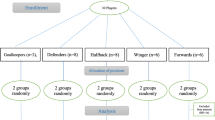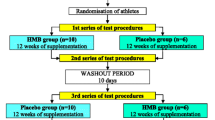Abstract
The use of ergogenic nutritional supplements is becoming inseparable from competitive sports. β-Hydroxy-β-Methylbutyric acid (HMB) has recently been suggested to promote fat-free mass (FFM) and strength gains during resistance training in adults. In this prospective randomized, double-blind, placebo-controlled study, we studied the effect of HMB (3 g/day) supplementation on body composition, muscle strength, anaerobic and aerobic capacity, anabolic/catabolic hormones and inflammatory mediators in elite, national team level adolescent volleyball players (13.5–18 years, 14 males, 14 females, Tanner stage 4–5) during the first 7 weeks of the training season. HMB led to a significant greater increase in FFM by skinfold thickness (56.4 ± 10.2 to 56.3 ± 8.6 vs. 59.3 ± 11.3 to 61.6 ± 11.3 kg in the control and HMB group, respectively, p < 0.001). HMB led to a significant greater increase in both dominant and non-dominant knee flexion isokinetic force/FFM, measured at fast (180°/sec) and slow (60°/sec) angle speeds, but had no significant effect on knee extension and elbow flexion and extension. HMB led to a significant greater increase in peak and mean anaerobic power determined by the Wingate anaerobic test (peak power: 15.5 ± 1.6 to 16.2 ± 1.2 vs. 15.4 ± 1.6 to 17.2 ± 1.2 watts/FFM, mean power: 10.6 ± 0.9 to 10.8 ± 1.1 vs. 10.7 ± 0.8 to 11.8 ± 1.0 watts/FFM in control and HMB group, respectively, p < 0.01), with no effect on fatigue index. HMB had no significant effect on aerobic fitness or on anabolic (growth hormone, IGF-I, testosterone), catabolic (cortisol) and inflammatory mediators (IL-6 and IL-1 receptor antagonist). HMB supplementation was associated with greater increases in muscle mass, muscle strength and anaerobic properties with no effect on aerobic capacity suggesting some advantage for its use in elite adolescent volleyball players during the initial phases of the training season. These effects were not accompanied by hormonal and inflammatory mediator changes.
Similar content being viewed by others
References
Bar-Or O (1987) The Wingate anaerobic test. An update on methodology, reliability and validity. Sports Med 4:381–394
Castro-Pinero J, Artero EG, Espana-Romero V, Ortega FB, Sjostrom M, Suni J, Ruiz JR (2009) Criterion-related validity of field-based fitness tests in youth: a systematic review. Br J Sports Med 30(9):658–662
Crawford PB, Obarzanek E, Morrison J, Sabry ZI (1994) Comparative advantage of 3-day food records over 24-hour recall and 5-day food frequency validated by observation of 9- and 10-year-old girls. J Am Diet Assoc 94:626–630
Decombaz J, Bury A, Hager C (2003) HMB meta-analysis and the clustering of data sources. J Appl Physiol 95:2180–2182
Eliakim A, Nemet D, Bar-Sela S, Higer Y, Falk B (2002) Changes in circulating IGF-I and their correlation with self-assessment and fitness among elite athletes. Int J Sports Med 23:600–603
Eliakim A, Nemet D, Cooper DM (2005) Exercise, training and the GH– > IGF-I axis. In: Kraemer WJ, Rogol AD (eds) The endocrine system in sports and exercise, 1. Wiley-Blackwell, Oxford, pp 165–179
Gallagher PM, Carrithers JA, Godard MP, Schulze KE, Trappe SW (2000) Beta-hydroxy-beta-methylbutyrate ingestion, part I: effects on strength and fat free mass. Med Sci Sports Exerc 32:2109–2115
Godin G, Shephard RJ (1985) A simple method to assess exercise behavior in the community. Can J Appl Sport Sci 10:141–146
Hoffman JR, Cooper J, Wendell M, Im J, Kang J (2004) Effects of beta-hydroxy beta-methylbutyrate on power performance and indices of muscle damage and stress during high-intensity training. J Strength Cond Res 18:747–752
Koziris LP, Hickson RC, Chatterton RT Jr, Groseth RT, Christie JM, Goldflies DG, Unterman TG (1999) Serum levels of total and free IGF-I and IGFBP-3 are increased and maintained in long-term training. J Appl Physiol 86:1436–1442
Kraemer WJ, Hatfield DL, Volek JS, Fragala MS, Vingren JL, Anderson JM, Spiering BA, Thomas GA, Ho JY, Quann EE, Izquierdo M, Hakkinen K, Maresh CM (2009) Effects of amino acids supplement on physiological adaptations to resistance training. Med Sci Sports Exerc 41:1111–1121
Kreider RB, Ferreira M, Wilson M, Almada AL (1999) Effects of calcium beta-hydroxy-beta-methylbutyrate (HMB) supplementation during resistance-training on markers of catabolism, body composition and strength. Int J Sports Med 20:503–509
Lamboley CR, Royer D, Dionne IJ (2007) Effects of beta-hydroxy-beta-methylbutyrate on aerobic-performance components and body composition in college students. Int J Sport Nutr Exerc Metab 17:56–69
Molnar GE, Alexander J (1974) Development of quantitative standards for muscle strength in children. Arch Phys Med Rehabil 55:490–493
Nemet D, Eliakim A (2007) Protein and amino acid supplementation in sport. Int SportMed J 8:11–23
Nemet D, Connolly PH, Pontello-Pescatello AM, Rose-Gottron C, Larson JK, Galassetti P, Cooper DM (2004a) Negative energy balance plays a major role in the IGF-I response to exercise training. J Appl Physiol 96:276–282
Nemet D, Pontello AM, Rose-Gottron C, Cooper DM (2004b) Cytokines and growth factors during and after a wrestling season in adolescent boys. Med Sci Sports Exerc 36:794–800
Nemet D, Wolach B, Eliakim A (2005) Proteins and amino acid supplementation in sports: are they truly necessary? Isr Med Assoc J 7:328–332
Nissen S, Sharp R, Ray M, Rathmacher JA, Rice D, Fuller JC Jr, Connelly AS, Abumrad N (1996) Effect of leucine metabolite beta-hydroxy-beta-methylbutyrate on muscle metabolism during resistance-exercise training. J Appl Physiol 81:2095–2104
Rowlands DS, Thomson JS (2009) Effects of beta-hydroxy-beta-methylbutyrate supplementation during resistance training on strength, body composition, and muscle damage in trained and untrained young men: a meta-analysis. J Strength Cond Res 23:836–846
Slater GJ, Jenkins D (2000) Beta-hydroxy-beta-methylbutyrate (HMB) supplementation and the promotion of muscle growth and strength. Sports Med 30:105–116
Slaughter MH, Lohman TG, Boileau RA, Horswill CA, Stillman RJ, Van Loan MD, Bemben DA (1988) Skinfold equations for estimation of body fatness in children and youth. Hum Biol 60:709–723
St Clair GA, Broomhead S, Lambert MI, Hawley JA (1998) Prediction of maximal oxygen uptake from a 20-m shuttle run as measured directly in runners and squash players. J Sports Sci 16:331–335
Thomson JS, Watson PE, Rowlands DS (2009) Effects of nine weeks of beta-hydroxy-beta-methylbutyrate supplementation on strength and body composition in resistance trained men. J Strength Cond Res 23:827–835
Vukovich MD, Dreifort GD (2001) Effect of beta-hydroxy beta-methylbutyrate on the onset of blood lactate accumulation and V(O)(2) peak in endurance-trained cyclists. J Strength Cond Res 15:491–497
Wilson GJ, Wilson JM, Manninen AH (2008) Effects of beta-hydroxy-beta-methylbutyrate (HMB) on exercise performance and body composition across varying levels of age, sex, and training experience: a review. Nutr Metab (Lond) 5:1
Zanchi NE, Gerlinger-Romero F, Guimaraes-Ferreira L, de Siqueira Filho MA, Felitti V, Lira FS, Seelaender M, Lancha AH, Jr (2010) HMB supplementation: clinical and athletic performance-related effects and mechanisms of action. Amino Acids, Epub ahead of print
Author information
Authors and Affiliations
Corresponding author
Additional information
Communicated by William J. Kraemer.
Rights and permissions
About this article
Cite this article
Portal, S., Zadik, Z., Rabinowitz, J. et al. The effect of HMB supplementation on body composition, fitness, hormonal and inflammatory mediators in elite adolescent volleyball players: a prospective randomized, double-blind, placebo-controlled study. Eur J Appl Physiol 111, 2261–2269 (2011). https://doi.org/10.1007/s00421-011-1855-x
Received:
Accepted:
Published:
Issue Date:
DOI: https://doi.org/10.1007/s00421-011-1855-x




